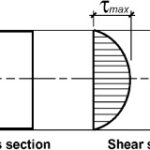a)  )
)
b) Now combining Strain curvature relation and Hooke’s Law we can get the Normal Stresses In Beams

c) When the curvature is positive, the stresses are negative (compression) above the neutral surface and vice-versa.
are negative (compression) above the neutral surface and vice-versa.
d) Now we need two more relationship to complete the derivation
i) Location of the neutral axis of the cross section, so that we can determine the distance y
ii) Relationship between the curvature and the bending moment
e) The above two relationship can be found out by determining the resultant (or net effect ) of  on the cross section area, which are as follows
on the cross section area, which are as follows
i) A Resultant force acting in the x-direction whose value is zero
ii) A moment acting about z-axis (in xy plane) whose values will be equal to the bending moment acting on that cross section
f) Location of neutral axis

Now  can be taken out as it is not a function of area i.e. they do not vary over the area
can be taken out as it is not a function of area i.e. they do not vary over the area

This equation states that the first moment of the area of the cross section, evaluated with respect to the z-axis, is zero. In other words, the z-axis must pass through the centroid of the cross section.
i) The neutral axis passes through the centroid of the cross-sectional area when the material follows Hooke’s law and there is no axial force acting on the cross section.
g) Moment-Curvature Relationship



Now  can be taken out as they not a function of area i.e. they do not vary over the area
can be taken out as they not a function of area i.e. they do not vary over the area

This integral  is known as moment of inertia of cross section with respect to z axis (i.e. w.r.t to neutral axis). The above equation can be rearranged into Moment-Curvature equation, where EI is known as flexural rigidity of beam.
is known as moment of inertia of cross section with respect to z axis (i.e. w.r.t to neutral axis). The above equation can be rearranged into Moment-Curvature equation, where EI is known as flexural rigidity of beam.

i) Flexural rigidity is a measure of the resistance of a beam to bending, that is, the larger the flexural rigidity, the smaller the curvature for a given bending moment.
ii) A positive bending moment produces positive curvature and a negative bending moment produces negative curvature
h) Flexure Formula
i) Now combining Moment-Curvature equation and Normal Stresses In Beams we will get

Stresses calculated from the flexure formula are called bending stresses or flexural stresses.
ii)  If the bending moment in the beam is positive, the bending stresses will be positive (tension) over the part of the cross section where y is negative, that is, over the lower part of the beam. The stresses in the upper part of the beam will be negative (compression). If the bending moment is negative, the stresses will be reversed.
If the bending moment in the beam is positive, the bending stresses will be positive (tension) over the part of the cross section where y is negative, that is, over the lower part of the beam. The stresses in the upper part of the beam will be negative (compression). If the bending moment is negative, the stresses will be reversed.


